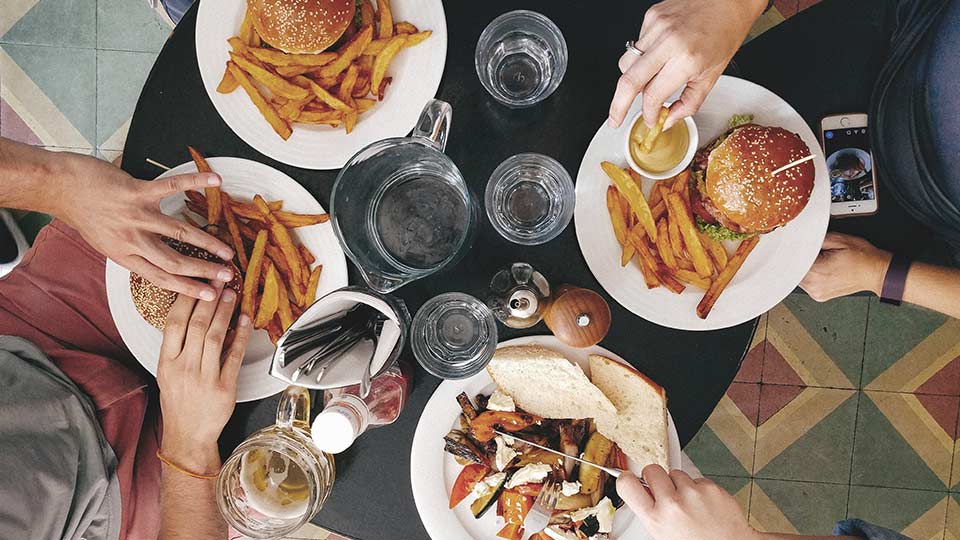I liked how articles would explain the science behind our feelings. And here is one: Cause of cravings and what we can do to ensure we don't overload the system.
Courtesy from Les Mills

The extremes of hunger and fullness are largely controlled by the communications between the brain (the nervous system nestled in your skull) and your ‘second brain’ (where a surprising amount of nerves and grey matter wrap in and around the digestive organs). Known as your enteric nervous system (ENS), this ‘second brain’ shares many of the same characteristics as the brain. There are billions of nerve connections and specialist regions producing their own array of neurotransmitters. However, unlike the brain, these nerves are focused on ensuring you regularly eat and that you digest what you have eaten.
The brain and ENS share many connections, so it’s not surprising that mood and stresses have a powerful impact on gut sensations and appetite control.
What your ENS does to help control hunger
As your stomach shrinks between meals, under the control of the ENS, ghrelin is released. Ghrelin is one of a number of recently discovered hormones produced by the gut that triggers feelings of either hunger or fullness. In the case of ghrelin, the rising levels in the blood trigger the nagging and incessant feelings of hunger. Once food is eaten, the levels of ghrelin in the blood fall rapidly and stay down for the next few hours, before slowing creeping up again.
As your stomach shrinks between meals, under the control of the ENS, ghrelin is released. Ghrelin is one of a number of recently discovered hormones produced by the gut that triggers feelings of either hunger or fullness. In the case of ghrelin, the rising levels in the blood trigger the nagging and incessant feelings of hunger. Once food is eaten, the levels of ghrelin in the blood fall rapidly and stay down for the next few hours, before slowing creeping up again.
Like someone constantly knocking on the door, the need to eat gradually passes from mild interruption to an overwhelming demand. It’s at the extreme end of this cycle that we will eat almost anything, with greedy need. Yet very soon this passes to fullness and potentially pain. Again the ENS triggers the sensation of fullness by firstly responding to the stretch sensors that are located on the stomach. These are powerful brakes trying to limit more food being eaten. Without these brakes there is the risk that the rest of the digestive system will be overloaded with excess food to digest. To avoid swamping the system the ENS emits pain signals and acts as a powerful brake on the rate at which the stomach empties into the small intestine. Even to the point of bursting, the ENS only allows the stomach to release a slow trickle of food for further digestion.
In the small intestine, the ENS controls the release of digestive hormones, and an entire lexicon of appetite regulation hormones – these include glucagon-like peptide (GLP), cholecystokinin (CCK), pancreatic polypeptide (PPP) and peptide YY (PYY). Each has a subtle role in helping communicate to the body and brain, not only how much has been eaten but how much protein, fat and carbohydrate was present in the meal. Protein rich meals are more potent stimulators and as a result contribute to longer lasting feelings of fullness and satiety.
The complexities of many nerves and hormones controlling hunger, appetite and satiety are not surprising when you consider how vital food is for survival. This explains why hunger signals are so powerful. Starvation has been a major factor that has shaped human evolution. A stomach-ache from overeating is then just a minor passing inconvenience in comparison to the insistent and overwhelming need to eat for the hungry.
FIVE WELL-ESTABLISHED STRATEGIES FOR STOPPING FOOD CRAVINGS
- Eat before you become ravenous
It’s easy to try and skip meals when you’re frantically busy and overwhelmed. It’s only a matter of time before the powerful forces of the gut-brain axis will have you freewheeling towards food – lots of food!
- Slow down the rate you eat (and drink water)
A meal consumed at a leisurely pace allows your ENS to manage and control the flow of appetite regulating hormones to maximal benefit. A slow and sustained release of gut hormones will have you feeling fuller and hunger-free for hours. Water has the same effect, by providing bulk and diluting the nutrients in the digestive tract.
- Avoid empty liquid calories
Sugar-sweetened beverages do little to quench hunger or bring on the feelings of fullness. They are just empty calories that have to go somewhere! Alcohol has an even more perverse effect. It stimulates hunger and provides extra calories, one sip at a time.
- Choose healthy proteins
Protein rich foods including beans, legumes, pulses and grains are a glorious blend of bulk and protein. Other healthy protein options including seafood, low fat dairy and eggs also provide sustained appetite controlling benefits.
- Make it flavorsome
Herbs and spices have complex and unique actions on appetite regulating hormones. From the fire of chillies to the bite of cinnamon, many herbs and spices have the ability to not only reduce the amount you eat at a meal, buts also make you feel fuller for longer.
Bon appetit.

Professor David Cameron-Smith is a regular Fit Planet contributor. A transplanted Australian, he obtained a PhD in nutritional biochemistry from Deakin University, and undertook postdoctoral training at the Royal Prince Alfred Hospital, Sydney. His research interests include the importance of nutrition in the maintenance of optimal health in an ageing population, and the impact of nutrition in regulating the function of muscles.
If you want more health and fitness inspiration simply sign up to Fit Planet and get the freshest insights and advice straight to your inbox.
Photo credit: Dan Gold






0 comments:
Post a Comment